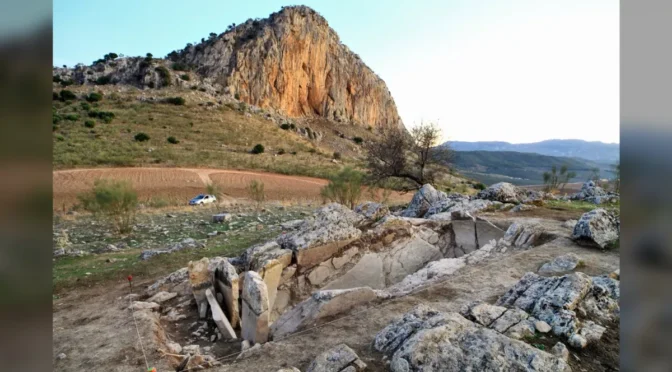5,400-year-old tomb discovered in Spain perfectly captures the summer solstice
Archaeologists have discovered a 5,400-year-old stone tomb beside a prominent lone mountain in southern Spain, indicating it was a local focus for the prehistoric people of the region.

Archaeologists have discovered a 5,400-year-old megalithic tomb near a prominent lone mountain in southern Spain, suggesting the peak may have been meaningful to prehistoric people there.
The area, in the countryside near the city of Antequera, is renowned for its megaliths — prehistoric monuments made from large stones — and the newly found tomb seems to solve one of the mysteries of their alignment.
The tomb was designed to funnel light from the rising midsummer sun into a chamber deep within — much like the contemporary megalithic tomb built more than 1,000 miles (1,600 kilometers) away at Newgrange in Ireland, suggesting both places shared similar beliefs about the afterlife more than 5,000 years ago.

“Newgrange is much bigger and more complex than the tomb we have discovered [in Spain], but they have something in common — the interest of the builders to use sunlight at a specific time of the year, to produce a symbolic — possibly magic — effect,” Leonardo García Sanjuán, an archaeologist at the University of Seville.
The bedrock at the site is tilted away from the position of the sunrise on the solstice at midsummer, so the builders deliberately constructed a cavity to admit its light, according to a study by García Sanjuán and his colleagues published April 14 in the journal Antiquity.
Related: 2,600-year-old stone busts of ‘lost’ ancient Tartessos people discovered in sealed pit in Spain
“They worked very cleverly to make an arrangement of stones, which were engraved and possibly painted,” he said. “These were sacred things placed so that the sunrise on the [summer] solstice would go straight into the back of the chamber.”

Megalithic tomb
The new study describes excavations by García Sanjuán and his team beside a prominent limestone mountain known as La Peña de los Enamorados — the Rock of the Lovers — named after a legend that says two star-crossed lovers once killed themselves by jumping off it.
The mountain is also famous because it looks like the profile of the head of a sleeping giant, especially at times of low light such as sunrise and sunset.
García Sanjuán and his colleagues excavated the tomb in late 2020 in the “neck” region of the mountain, near the Matacabras rock shelter, which is adorned with pictographs thought to be painted about 5,800 years ago. They think the tomb was first built a few hundred years after the rock paintings were made, and that it was used for burials for more than 1,000 years.

The archaeologists have found several deposits of human remains in the newfound tomb, dating from three major phases of its use, as well as pieces of pottery.
Ancient landscape

The Antequera area is famed for its natural rock formations like La Peña and the megalithic monuments in the region, which may have been influenced by the local geography. The most famous is the Dolmen of Menga — one of the largest and oldest megalithic structures in Europe, which was built between 3800 B.C. and 3600 B.C.
But the passage in Menga is not aligned to a solstice sunrise or sunset, as might be expected — instead, Menga points toward La Peña de los Enamorados, about 4 miles (6.5 km) to the northeast. (The other two megaliths in the region were built later and seem to point elsewhere.)
The alignment suggests La Peña was an important focus for local prehistoric people and solves a mystery of where Menga was pointing: to the location of both the rock art and the newly found tomb at La Peña, while the tomb at La Peña itself pointed to the solstice sunrise, García Sanjuán said.
The inner chamber of the newfound tomb is decorated with a distinctive stone with ripple marks on its surface, which was taken from a region that had once been a beach or part of the seabed.

The stone was placed so that the light from the rising midsummer sun fell upon it; and the part of the burial chamber in front of it seems to have been kept clear of human remains, García Sanjuán said.
“These people chose this stone precisely because it created these waving, undulating shapes,” he said. “This was very theatrical… they were very clever in producing these special visual effects.”
He noted that megalithic structures have been found from Morocco to Sweden, and that the people who built them seem to have had similar beliefs.
“There are differences as well, but one common element is the sun,” García Sanjuán said. “The sun was at the center of the worldview of these people.”
